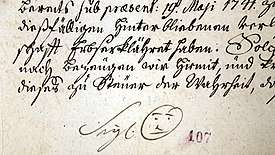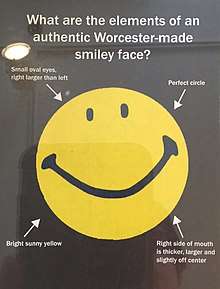Smiley
A smiley, sometimes referred to as a smiley face, is a basic ideogram that represents a smiling face, which has become part of popular culture worldwide. In modern times, the smiley has mostly been known for its yellow face and has evolved from a simple smiling face to display a range of facial emotions. Drawings of smileys have been traced back to ancient times, often displayed in caves and were often just two eyes and a curved upwards mouth.

The classic form designed by Harvey Ball in 1963 comprises a yellow circle with two black dots representing eyes and a black arc representing the mouth (![]()
:-),:-D,:), =), =D, :D, or (: that resemble a smiling face when viewed after rotation through 90 degrees. "Smiley" is also sometimes used as a generic term for any emoticon (see Emoji). The smiley has been referenced in nearly all areas of Western culture including music, movies, and art. The smiley has also been associated with late 1980s and early 1990s rave culture.[1][2][3]
The plural form "smilies" is commonly used,[4] but the variant spelling "smilie" is not as common as the "y" spelling.[5]
History
Early history of smiling faces
For thousands of years, smiling faces have been used as ideograms and as pictograms. In recent times, the face now known as a smiley has evolved into a well-known image and brand, recognisable for its yellow and black features. It wasn't until the 1900s that the design evolved from a basic eyes and mouth design, into a more recognisable design.
The oldest known smiling face was found by a team of archaeologists led by Nicolò Marchetti of the University of Bologna. Marchetti and his team pieced together fragments of a Hittite pot from approximately 1700 BC that had been found in Karkamış, Turkey. Once the pot had been pieced together, the team noticed that the item had a large smiling face engraved on it, becoming the first item to with such a design to be found.[6] In 1635, a gold smiling face was drawn on the bottom of a legal document in Slovakia, appearing next to lawyer's Jan Ladislaides signature.[7]

The Danish poet and author Johannes V. Jensen was amongst other things famous for experimenting with the form of his writing. In a letter sent to publisher Ernst Bojesen in December 1900, he includes both a happy face and a sad face.
One of the first commercial uses of a smiling face was in 1919, when the Buffalo Steam Roller Company in Buffalo, New York applied stickers on receipts with the word "thanks" and a smiling face above it. The face contained a lot of detail, having eyebrows, nose, teeth, chin and facial creases, reminiscent of "man-in-the-moon" style characteristics.
Ingmar Bergman's 1948 film Port of Call includes a scene where the unhappy Berit draws a sad face – closely resembling the modern "frowny", but including a dot for the nose – in lipstick on her mirror, before being interrupted.[8] In 1953 and 1958, similar happy faces were used in promotional campaigns for the films Lili (1953) and Gigi (1958).
The yellow and black happy face
In the United States, the first time a combination of yellow and black was used for a smiling face was in late 1962. During the 1960s and early 70s, a number of designers created smiling faces, which were categorised as "happy faces." The WMCA happy face, became synonymous with 1960s culture in New York City. The New York-based radio station used the happy face as part of a competition for listeners. When the station called listeners, any listener who answered their phone "WMCA Good Guys!" was rewarded with a "WMCA good guys" sweatshirt that incorporated the yellow and black happy face into its design. Throughout the 1960s, thousands of these sweatshirts were given away.[9][10][11] The features of the WMCA smiley was a yellow face, with black dots as eyes and had a slightly crooked smile. The outline of the face was also not smooth to give it more of a handrawn look.[11] Originally, the yellow and black sweatshirt (sometimes referred to as gold), had WMCA Good Guys written on the front with no smiley face.[12]
According to the Smithsonian Institution, the smiley face as we know it today was created by Harvey Ross Ball, an American graphic artist.[13] In 1963, Ball was employed by State Mutual Life Assurance Company of Worcester, Massachusetts (now known as Hanover Insurance) to create a happy face to raise the morale of the employees. Ball created the design in ten minutes and was paid $45 (equivalent to $376 in 2019). His rendition, with a bright yellow background, dark oval eyes, full smile, and creases at the sides of the mouth,[11] was imprinted on more than fifty million buttons and became familiar around the world. The design is so simple that it is certain that similar versions were produced before 1963, including those cited above. However, Ball’s rendition, as described here, has become the most iconic version.[10][14] In 1967, Seattle graphic artist George Tenagi drew his own version at the request of advertising agent, David Stern. Tenagi's design was used in an advertising campaign for Seattle-based University Federal Savings & Loan. The ad campaign was inspired by Lee Adams's lyrics in "Put on a Happy Face" from the musical Bye Bye Birdie. Stern, the man behind this campaign, also later incorporated the Happy Face in his run for Seattle mayor in 1993.[14]
The graphic was further popularized in the early 1970s by Philadelphia brothers Bernard and Murray Spain, who seized upon it in September 1970 in a campaign to sell novelty items. The two produced buttons as well as coffee mugs, t-shirts, bumper stickers and many other items emblazoned with the symbol and the phrase "Have a happy day", which mutated into "Have a nice day". Working with New York button manufacturer NG Slater, some 50 million happy face badges were produced by 1972.[15]
Evolution into the smiley
In 1972, Frenchman Franklin Loufrani became the first person to legally trademark the use of a smiley face. He used it to highlight the good news parts of the newspaper France Soir. He simply called the design "Smiley" and launched The Smiley Company. In 1996 Loufrani's son Nicolas Loufrani took over the family business and built it into a multinational corporation. Nicolas Loufrani was outwardly skeptical of Harvey Ball's claim to creating the first smiley face. While noting that the design that his father came up with and Ball's design were nearly identical, Loufrani argued that the design is so simple that no one person can lay claim to having created it. As evidence for this, Loufrani's website points to early cave paintings found in France (2500 BC) that he claims are the first depictions of a smiley face. Loufrani also points to a 1960 radio ad campaign that reportedly made use of a similar design.[16]

The rights to the Smiley trademark in one hundred countries are owned by the Smiley Company.[17] Its subsidiary SmileyWorld Ltd, in London, headed by Nicolas Loufrani, creates or approves all the Smiley products sold in countries where it holds the trademark.[18] The Smiley brand and logo have significant exposure through licensees in sectors such as clothing, home decoration, perfumery, plush, stationery, publishing, and through promotional campaigns.[19] The Smiley Company is one of the 100 biggest licensing companies in the world, with a turnover of US$167 million in 2012.[20] The first Smiley shop opened in London in the Boxpark shopping centre in December 2011.[21]
In 1997, Franklin Loufrani and Smiley World attempted to acquire trademark rights to the symbol (and even to the word "smiley" itself) in the United States. This brought Loufrani into conflict with Wal-Mart, which had begun prominently featuring a happy face in its "Rolling Back Prices" campaign over a year earlier. Wal-Mart responded first by trying to block Loufrani's application, then later by trying to register the smiley face itself; Loufrani, in turn, sued to stop Wal-Mart's application, and in 2002 after the issue went to court,[22] where it would languish for seven years before a decision.
Wal-Mart began phasing out the smiley face on its vests[23] and its website[24] in 2006. Despite that, Wal-Mart sued an online parodist for alleged "trademark infringement" after he used the symbol (as well as various portmanteaus of "Wal-", such as "Walocaust"). The District Court found in favor of the parodist when in March 2008, the judge concluded that Wal-Mart's smiley face logo was not shown to be "inherently distinctive" and that it "has failed to establish that the smiley face has acquired secondary meaning or that it is otherwise a protectable trademark" under U.S. law.[25]
In June 2010, Wal-Mart and the Smiley Company founded by Loufrani settled their 10-year-old dispute in front of the Chicago federal court. The terms remain confidential.[26] In 2016, Wal-Mart brought back the smiley face on its website, social media profiles, and in selected stores.[27]
In text
The earliest known smiley-like image in a written document was drawn by a Slovak notary to indicate his satisfaction with the state of his town's municipal financial records in 1635.[28] A disputed early use of the smiley in a printed text may have been in Robert Herrick's poem To Fortune (1648),[29] which contains the line "Upon my ruins (smiling yet :)". Journalist Levi Stahl has suggested that this may have been an intentional "orthographic joke", while this occurrence is likely merely the colon placed inside parentheses rather than outside of them as is standard typographic practice today -- (smiling yet):. There are citations of similar punctuation in a non-humorous context, even within Herrick's own work.[30] It is likely that the parenthesis was added later by modern editors.[31]
On the Internet, the smiley has become a visual means of conveyance that uses images. The first known mention on the Internet was on September 19, 1982, when Scott Fahlman from Carnegie Mellon University wrote:
I propose that [sic] the following character sequence for joke markers::-). Read it sideways. Actually, it is probably more economical to mark things that are NOT jokes, given current trends. For this, use: :-(.[32][33]
Yellow graphical smileys have been used for many different purposes, including use in early 1980s video games. Yahoo! Messenger (from 1998) used smiley symbols in the user list next to each user, and also as an icon for the application. In 2001, SmileyWorld launched the website "The official Smiley dictionary",[34] with smileys proposed to replace ASCII emoticons (i.e. emojis). In November 2001, and later, smiley emojis inside the actual chat text was adopted by several chat systems, including Yahoo Messenger.
The smiley is the printable version of characters 1 and 2 of (black-and-white versions of) codepage 437 (1981) of the first IBM PC and all subsequent PC compatible computers. For modern computers, all versions of Microsoft Windows after Windows 95[35] can use the smiley as part of Windows Glyph List 4, although some computer fonts miss some characters.[36]
The smiley face was included in Unicode's Miscellaneous Symbols from version 1.1 (1993).[37]
| Unicode smiley characters: | |||
| ☺ | U+263A | Alt+1 | White Smiling Face (This may appear as an emoji on some devices) |
| ☻ | U+263B | Alt+2 | Black Smiling Face |
| Miscellaneous Symbols also contains the frowning face: | |||
| ☹ | U+2639 | White Frowning Face | |
Later additions to Unicode included a large number of variants expressing a range of human emotions, in particlar with the addition of the "Emoticons" and "Supplemental Symbols and Pictographs blocks in Unicode versions 6.0 (2010) and 8.0 (2015), respectively. These were introduced for compatibility with the ad-hoc implementation of emoticons by Japanese telephone carriers in unused ranges of the Shift JIS standard. This resulted in a de-facto standard in the range with lead bytes 0xF5 to 0xF9.[38] KDDI has gone much further than this, and has introduced hundreds more in the space with lead bytes 0xF3 and 0xF4.[39]
In popular culture
The smiley has now become synonymous with culture across the world. It is used for communication, imagery, branding and for topical purposes to display a range of emotions. Beginning in the 1960s, a yellow happy face was used by numerous brands in print to demonstrate happiness.
In print
Franklin Loufrani first introduced the word smiley when he designed a smiling face for the newspaper he was working for at the time. The Loufrani design came in 1971, when Loufrani designed a smiley face for the newspaper, France-Soir. The newspaper used Loufrani's smiley to highlight stories that they defined as "feel-good news."[40] This particular smiley went onto form The Smiley Company. Mad magazine notably used the smiley a year later in 1972 across their entire front page for the April edition of the magazine. This was one of the first instances that the smiling face had been adapted, with one of the twenty visible smileys pulling a face.[41]
In the United States, there were many instances of smiling faces in the 1900s. However, the first industry to mass adopt the smiley was in comics and cartoons.
Music
As music genres began to create their own cultures from the 1970s onwards, many cultures began to incorporate a smiling face into their culture. In the late 1970s, the American band Dead Kennedys launched their first recording, "California Über Alles". The single cover was a collage aimed to look like that of a Nazi rally prior to World War II. The usual swastika banners used at rallies, was replaced on the single cover with three large smileys.[42] In the UK, the happy face has been associated with psychedelic culture since Ubi Dwyer and the Windsor Free Festival in the 1970s and the electronic dance music culture, particularly with acid house, that emerged during the Second Summer of Love in the late 1980s. The association was cemented when the band Bomb the Bass used an extracted smiley from the comic book series Watchmen on the center of its "Beat Dis" hit single.

In the late-1980s, the smiley again became a prominent image within the music industry. It was adopted during the growth of acid house across Europe and the UK in the late 1980s. According to many, this began when DJ, Danny Rampling, used the smiley to celebrate Paul Oakenfold's birthday.[43] This sparked a movement where the smiley moved into various dance genres, becoming a symbol of 1980s dance music.[44]
Gaming
In 1980, Namco released the now famous Pac-man, a yellow faced cartoon character. In 2008, the video game Battlefield: Bad Company used the yellow smiley as part of its branding for the game. The smiley appeared throughout the game and also on the cover. The smiley normally appeared on the side of a grenade, which is something that became synonymous with the Battlefield series.[45]
Film
The logo for the Watchmen comic book series includes a smiley with blood on top of it. In the film Suicide Squad, the character Deadshot stares into the window of a clothing store. Behind a line of mannequins is a yellow smiley face pin, which had been closely associated to another DC comic character, Comedian.[46]
Art
As part of his early works, graffiti artist Banksy frequently used the smiley in his art. The first of his major works that included a smiley was his Flying Copper portrait, which was completed in 2004. It was during a period when Banksy experimented with working on canvas and paper portraits. He also used the smiley in 2005 to replace the face of the grim reaper. The image became known as "grin reaper."[47][48]
Other uses
During the London 2012 opening ceremony, early on in the show a number of giant beach balls were released into the audience. All of them were yellow and had a large smiley face on each of them.[49]
See also
| Wikimedia Commons has media related to: |
References
- Jon Savage (February 21, 2009). "Smiley Face Design History". Retrieved October 5, 2016.
- Michaelangelo Matos (December 21, 2016). "A Brief History of the Smiley Face, Rave Culture's Most Ubiquitous Symbol". Retrieved May 1, 2017.
- Lim, Brian (July 23, 2015). "The Evolution of Rave Fashion". Retrieved May 1, 2017.
- Google Ngram Viewer: smilies vs smileys
- Google Ngram Viewer: smilie vs smiley
- Borschel-Dan, Amanda (July 19, 2017). "History's 'oldest smile' found on 4,000-year-old pot in Turkey". The Times of Israel. Retrieved July 28, 2017.
- Ghosh, Shreesha. "World's Oldest Emoji Discovered? Scientists In Slovakia Say They Found 'Smiley Face Emoji'". International Business Times.
- Ingmarbergman.se. A still from the scene.
- Alastair Sooke (February 3, 2012), "Smiley's People (Radio 4): The million dollar smile", The Telegraph,
[Loufrani] points out that a smiley face was a key feature of a well-known promotional campaign for a radio network on America’s East Coast in the late Fifties.
- Honan, William H. (April 14, 2001). "H. R. Ball, 79, Ad Executive Credited With happy Face". The New York Times. Retrieved August 29, 2009.
- Doug Lennox, illustrated by Catriona Wight (2004), Now You Know More: The Book of Answers, Now You Know, 2 (illustrated ed.), Dundurn, p. 50, ISBN 9781550025309
- "Focus on Deejay Scene". Billboard. December 15, 1962. p. 34.
- Stamp, Jimmy (March 13, 2013). Who really invented the Smiley face. Washington DC: Smithsonian. Retrieved May 29, 2015.
- Adams, Cecil (April 23, 1993). "Who invented the smiley face?". The Straight Dope. Retrieved April 18, 2011.
- Peter Shapiro, "Smiling Faces Sometimes", in The Wire, issue 203, January 2001, pp. 44–49.
- Jimmy Stamp. "Who Really Invented the Smiley Face?". Smithsonian.
- Crampton, Thomas (July 5, 2006). "Smiley Face Is Serious to Company". The New York Times.
- "The Man Who Owns the Smiley Face". Vice. August 10, 2017. Retrieved January 24, 2018.
- "Smiley Licensing | Company Profile by". Licensing.biz. Archived from the original on February 29, 2012. Retrieved March 14, 2013.
- "Global License : Ranking the brands" (PDF). Rankingthebrands.com. Retrieved September 21, 2018.
- Giedrius Ivanauskas (January 16, 2012). "Boxpark Shoreditch: Interview with Nicolas Loufrani CEO of Smiley | Made in Shoreditch - A Magazine About Style, Innovation, Dining, Nightlife and People in Shoreditch". Made in Shoreditch. Archived from the original on March 7, 2013. Retrieved March 14, 2013.
- "Wal-Mart seeks smiley face rights". BBC News. May 8, 2006. Retrieved May 9, 2006.
- Kabel, Mark (October 22, 2006). "Wal-Mart phasing out smiley face vests". Associated Press.
- Williamson, Richard (October 30, 2006). "The last days of Wal-Mart's smiley face". Adweek.
- "Smith v. Wal-Mart Stores, Inc". Citizen Vox. March 28, 2008. The relevant text is in the Order granting summary judgment: Timothy C. Batten, Sr., "ORDER" (March 21, 2008)", section "B. Threshold Issue: Trademark Ownership", case "1:06-cv-00526-TCB", document 103, pages 15-19
- Sony, Astellas, Intel, Apple, Wal-Mart, Warner: Intellectual Property Victoria Slind-Flor, July 1, 2011, Bloomberg. The case is Loufrani v. Wal-Mart Stores Inc., 1:09-cv- 03062, U.S. District Court, Northern District of Illinois (Chicago).
- Smith, Aaron (June 2, 2016). "Walmart's Smiley is back after 10 years and a lawsuit". CNNMoney. Retrieved January 18, 2017.
- Votruba, Martin. "17th-century Emoji". Slovak Studies Program. University of Pittsburgh.
- Madrigal, Alexis C. (April 14, 2014). "The First Emoticon May Have Appeared in ... 1648". The Atlantic. Retrieved April 15, 2014.
- "Emoticon: Robert Herrick's 17th-century poem "To Fortune" does not contain a smiley face". Slate Magazine.
- "smileys, emoticons, typewriter art". Text Patterns - The New Atlantis.
- Fahlman's original message Retrieved October 27, 2013.
- "Smiley Lore :-)". cmu.edu.
- "Wayback Machine". March 31, 2001. Archived from the original on March 31, 2001. Retrieved September 21, 2018.
- "WGL Assistant v1.1: The Multilingual Font Manager". Archived from the original on March 24, 2008.
- Announcing WGL Assistant. Announcement: WGL Assistant V1.1 Beta available, comp.fonts, July 27, 1999, Microsoft Typography – News archive.
- wikibooks:Unicode/Character reference/2000-2FFF
- "Original Emoji from DoCoMo". FileFormat.info.
- "Original Emoji from KDDI". FileFormat.info.
- Golby, Joel (August 9, 2017). "The Man Who Owns the Smiley Face". Vice.
- "Front cover of Mad" (150). Mad. April 1972. p. 1.
- Johnson, Heather. "Dead Kennedys' 'California Uber Alles' Archived 2014-11-10 at the Wayback Machine". Mix Online. October 1, 2005.
- "The strange, tangled history of the acid house smiley". Red Bull.
- "Acid History: How The Smiley Became The Iconic Face Of Rave". ElectronicBeats magazine.
- "Hands-on: Battlefield - Bad Company". Wired. February 28, 2008.
- Steinberg, Nick. "20 Hidden Details In 'Suicide Squad' You May Have Missed". Goliath.
- "The Staying Power of the Smiley Face". Artsy. August 15, 2019.
- O'Brien, Jennifer. "Banksy to sell works at Art Source fair in Dublin". The Times.
- Gunn, Frank (July 28, 2012). "Spectators play with giant smiley face beach balls during the pre-show for the Olympic Games Opening ceremonies in London on Friday July 27, 2012". Vancouver Sun.